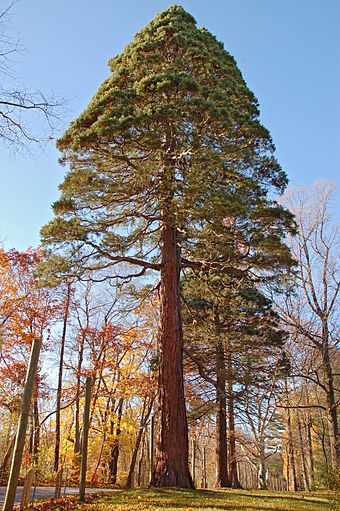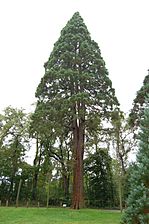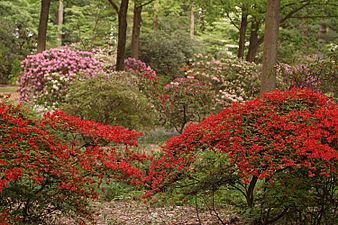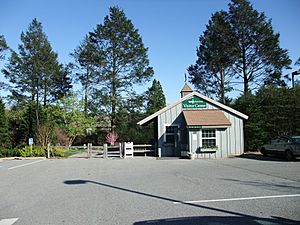John J. Tyler Arboretum facts for kids
Tyler Arboretum is a super cool place in Pennsylvania where you can explore nature! It's like a giant outdoor museum for trees and plants. This special place has been around for a long time and is home to many amazing plants, including some really old and rare trees. You can visit it in Middletown Township, Delaware County, Pennsylvania.
The arboretum is open almost every day. There is a small fee for visitors who are not members.
Contents
A Long History of Nature
The story of Tyler Arboretum began way back in 1681. That's when William Penn, who founded Pennsylvania, gave land to an English Quaker named Thomas Minshall. This land is where the arboretum stands today!
For over 260 years, the same family lived on this property. Eight different generations called it home!
How the Arboretum Started
In 1825, two brothers from the family, Jacob and Minshall Painter, had a great idea. They decided to set aside some of their land. On this land, they started planting more than 1,000 different kinds of trees and shrubs. This was the beginning of the arboretum!
Later, in 1944, a descendant named Laura Tyler left the property to become a non-profit arboretum. She wanted it to be a special place to remember her husband, John J. Tyler.
In 2001, Tyler Arboretum was added to the National Register of Historic Places. This means it's recognized as an important historical site.
Exploring Tyler Arboretum Today
Today, Tyler Arboretum is a very popular spot. About 70,000 people visit each year! The arboretum covers 650 acres, which is like 490 football fields. It has 17 miles of paths and hiking trails for you to explore.
The arboretum has many amazing plant collections. Here are some of the main ones:
The Original Painter Trees
These are some of the first trees planted by the Painter brothers. Many of them are still growing strong!
- Lebanon Cedar: This huge tree is a Pennsylvania state champion!
- Ginkgo: A unique tree with fan-shaped leaves.
- Yulan Magnolia: Another Pennsylvania state champion, known for its beautiful flowers.
- Sugar Maple and Red Maple: These trees are famous for their colorful leaves in the fall.
- Osage-orange: A very tough tree. A hurricane blew one down in 1954, but its strong trunk remains.
- Giant Sequoia: This is the biggest giant sequoia in Pennsylvania! It might even be the largest in the eastern United States.
- Baldcypress: A tree that can grow in wet areas.
- Tuliptree: Known for its tulip-shaped flowers.
- Oriental Spruce: Another Pennsylvania state champion tree.
Beautiful Flowering Plants
Tyler Arboretum also has many collections of ornamental plants. These are plants grown for their beauty, especially their flowers.
- Flowering Cherries: This collection started in 1951. It has many different types of cherry trees.
- Magnolias: Another collection started in 1951, featuring beautiful magnolia flowers.
- Crabapples: These trees have pretty blossoms in spring.
- Rhododendrons and Azaleas: Begun in 1959, this collection has hundreds of these colorful shrubs.
- Hollies and Lilacs: More lovely plants to admire.
Forests and Special Areas
- Pinetum: This is a large area, about 85 acres, filled with cone-bearing trees. You can find pines, spruces, hemlocks, firs, cedars, cypresses, and larches here. It started in 1954.
- Native Woodland Walk: This trail, started in 1970, lets you see plants that naturally grow in the local forests.
- Meadow Maze: This is a fun maze made from meadow grasses. It has four rings and is based on an old design.
- Pink Hill: This area is special because it has serpentine stone. This unique rock helps certain wildflowers grow that you might not see elsewhere.
- Uncultivated Land: About 450 acres of the arboretum are left natural. This wild area has 17 miles of marked hiking trails for you to explore.
- Wister Rhododendron Collection: This collection has over 500 different rhododendrons, making it a truly colorful sight.
Gallery
-
Giant Sequoia (Sequoiadendron giganteum)







